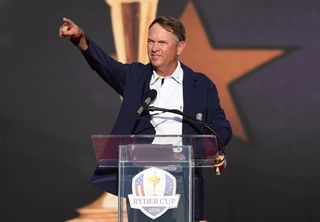Are America Great Again?
Nick Bonfield looks at the USA's recent history in the Ryder Cup and ahead to the 2018 event in Paris.


Nick Bonfield looks at the USA's recent history in the Ryder Cup and ahead to the 2018 event in Paris.
Are America Great Again?
Turn the clock back to October 2014. America were toiling after a comprehensive defeat at Gleneagles, while European golf fans were brimming with hubris following an eighth Ryder Cup success in the last ten stagings of the event. The PGA of America – reflecting on a third successive loss – decided enough was enough and instituted a Task Force in an attempt to address recent shortcomings and establish a blueprint for future success.
As you might imagine, it received a mixed reception. Those on the Task Force itself, like Tiger Woods and Phil Mickelson, extolled its merits, with the former referring to it as a “great step”. Others, meanwhile, approached the topic with more derision.
Many golf fans and members of the media felt it brought unnecessary added pressure at a time of obvious American vulnerability, with a seemingly last-chance-saloon element that simply wasn’t required given the nation’s precarious relationship with golf’s biggest event.

It was also received with a mixture of surprise and ridicule from members of the 2014 European Ryder Cup team. Lee Westwood tweeted shortly after the announcement: “What a massive pat on the back and confidence boost it is for Europe that team USA needs to create a Ryder Cup Task Force!!”, while Rory McIlroy said Europe’s success “wasn’t rocket science”.
Some felt the Ryder Cup was at a crossroads after the result in 2014; that another American defeat would irreparably damage interest in the event. While I never subscribed to that argument, the PGA of America clearly felt drastic action was needed. And drastic action can go one of two ways: rectify an issue, or plunge a team or organisation into further despair. The adage that pressure can either burst pipes or make diamonds seems apposite here.
Get the Golf Monthly Newsletter
Subscribe to the Golf Monthly newsletter to stay up to date with all the latest tour news, equipment news, reviews, head-to-heads and buyer’s guides from our team of experienced experts.
In February 2015, the conclusions of the Task Force were revealed. Davis Love III – the man who was widely praised for his performance at Medinah and simply couldn’t have done anything about Europe’s miraculous comeback – was announced as captain, new criteria were specified for the selection of vice-captains and changes were made to the team selection process.

You can decide for yourselves how influential this all was in America’s resounding triumph at Hazeltine in 2016 – it could, after all, have simply been a case of a group of players playing better golf than another group of players. But what was evident in Minnesota was a clear gameplan; a blueprint backed by all the players who, crucially, were given a voice – a contrast to Tom Watson’s ill-fated leadership at Gleneagles that sparked fierce public criticism from Mickelson and set the Task Force wheels in motion.
As we look ahead to the 42nd Ryder Cup at Le Golf National in Paris, it’s hard not to be struck by the significant shift in attitude surrounding the American team. Two years ago, some columns painted an apocalyptic picture of the Ryder Cup should the Americans fail to get to job done. Now, the confidence emanating from many US media outlets, and indeed some European ones, is unwavering.

Alan Shipnuck, a well-respected American golf writer, penned a column at the end of last year that included the following paragraph: “One of the greatest events in sport is on the verge of irrelevancy. The young, talented, hungry golfers from the United States are going to roll to victory in 2018 in Paris. This will set the stage for a decade-plus of blowouts, sapping the intrigue out of the Ryder Cup.”
Remember when Europe were on the verge of “sapping the intrigue out of the Ryder Cup”? While I’m sure this column was partly designed to spark debate and increase page views in our ‘clickbait’ era, there’s no doubt in my mind the sentiment is genuine. How quickly things can change in sport, both in terms of reality and perception.
In fairness, the article made some interesting points about the age of some European stalwarts and the strength of the current American crop. Lee Westwood, Ian Poulter, Henrik Stenson, Justin Rose and Sergio Garcia are either in, or approaching, their 40s, and the likes of Jordan Spieth, Brooks Koepka, Justin Thomas, Rickie Fowler and Patrick Reed are yet to turn 30.
Article Continues Below
Expand Ryder Cup Teams 2021 – Whistling Straits

Ryder Cup Teams 2021 – Whistling Straits
The Ryder Cup teams are complete - here…
Expand Who Are The Ryder Cup Captains And Vice Captains 2021?

Who Are The Ryder Cup Captains And Vice Captains 2021?
Who are the Ryder Cup captains for the…
Expand How To Watch The Ryder Cup Without Sky Sports

How To Watch The Ryder Cup Without Sky Sports
Find out how to legally watch the Ryder…
Expand Dan Walker: The Ryder Cup Is A Magical Three Days

Dan Walker: The Ryder Cup Is A Magical Three Days
Dan Walker reminisces about past Ryder Cups, and…
What’s more, the Americans will be buoyed by recent successes in other team events. The US currently holds the Presidents, Walker, Solheim and Curtis Cups, all of which were secured in convincing fashion.
But does all this guarantee an American victory in Paris? Absolutely not. The Europeans also look very strong and experience could play a key role on a demanding golf course.
Still, an objective observer would surely have to concede that a continued spell of European dominance in the Ryder Cup is about as likely as Tiger Woods breaking Jack Nicklaus’ Major record.
For all the latest news on the Ryder Cup, follow Golf Monthly on Facebook, Twitter and Instagram.

Nick Bonfield joined Golf Monthly in 2012 after graduating from Exeter University and earning an NCTJ-accredited journalism diploma from News Associates in Wimbledon. He is responsible for managing production of the magazine, sub-editing, writing, commissioning and coordinating all features across print and online. Most of his online work is opinion-based and typically centres around the Majors and significant events in the global golfing calendar. Nick has been an avid golf fan since the age of ten and became obsessed with the professional game after watching Mike Weir and Shaun Micheel win The Masters and PGA Championship respectively in 2003. In his time with Golf Monthly, he's interviewed the likes of Rory McIlroy, Justin Rose, Jose Maria Olazabal, Henrik Stenson, Padraig Harrington, Lee Westwood and Billy Horschel and has ghost-written columns for Westwood, Wayne Riley, Matthew Southgate, Chris Wood and Eddie Pepperell. Nick is a 12-handicap golfer and his favourite courses include Old Head, Sunningdale New, Penha Longha, Valderrama and Bearwood Lakes. If you have a feature pitch for Nick, please email nick.bonfield@futurenet.com with 'Pitch' in the subject line. Nick is currently playing: Driver: TaylorMade M1 Fairway wood: TaylorMade RBZ Stage 2 Hybrid: Ping Crossover Irons (4-9): Nike Vapor Speed Wedges: Cleveland CBX Full Face, 56˚, Titleist Vokey SM4, 60˚ Putter: testing in progress! Ball: TaylorMade TP5x
-
 'Gator Netting Is In Place' - Chevron Championship Venue Prepared For 'Safe' Winner's Jump
'Gator Netting Is In Place' - Chevron Championship Venue Prepared For 'Safe' Winner's JumpA tradition which began at the tournament's previous home could continue this year - if the champion is feeling brave enough...
By Jonny Leighfield Published
-
 New Balance 997 SL Golf Shoe Review
New Balance 997 SL Golf Shoe ReviewNew Balance produce some extremely stylish footwear and, in this review, Matt Cradock takes their spikeless 997 SL onto the course
By Matt Cradock Published